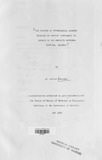| dc.contributor.author | Odhiambo, Alfred | |
| dc.date.accessioned | 2013-05-24T07:14:55Z | |
| dc.date.available | 2013-05-24T07:14:55Z | |
| dc.date.issued | 1993-05 | |
| dc.identifier.citation | Master of Medicine in Diagnostic Radiology of the University of Nairobi, 1993 | en |
| dc.identifier.uri | http://erepository.uonbi.ac.ke:8080/xmlui/handle/11295/25147 | |
| dc.description.abstract | A one year prospective study was carried out at the,
Kenyatta National Hospital (KNH) to establish the
pattern of intracranial lesions detectable by cranial
sonography in 100 infants. Patients were recruited from
the paediatric wards and clinics with varied neurological
signs and symptoms.
A real time, B mode scanner with 3MHZ and SMHZ sector
scanning transducers was used to obtain coronal and sagital
images of the infants brains. The number of female infants
practically equalled their male counterparts. 77% of the
infants presented for scanning at or below 6 months of
age. Thus 23% of the patients were aged between 7 months
and 12 months.
The three commonest symptoms were convulsions, fever
and enlargement of the head. The combined accounted for
88% of the presenting symptoms. A few patients had two
or more presenting symptoms. Enlargement of the head
especially when confirmed by measurement of the head
circumference was found to be an important symptom and
sign. Its presence is a strong indicator that a structural
abnormality of the brain detectable by ultrasound is
present.
Meningitis was the commonest clinical indication
for requesting ultrasound evaluation and was diagnosed
in 35 infants. Out of these, 30 infants (86%) had
normal sonographic findings. 3 had previously
unsuspected hydrocephalus and 2 had abscesses. This
confirms the limited role of cranial ultrasound in acute
meningitis.
Hydrocephalus was suspected clinically in 31 patients
and confirmed by ultrasound in.27 of these patients,
demonstrating good correlation between clinical suspicion
and sonographic results. 10 unsuspected cases sent for
other reasons were found to have hydrocephalus. Curiously,
however, 22 female infants had hydrocephalus while only
15 male patients had sonographically demonstrated hydrocephalus.
Also notable was the fact that all the abscesses and neoplasm
were diagnosed in only male infants.
Intracranial hemorrhage was suspected in 11 patients
but only confirmed in 4 cases (36%). The other 2 infants
diagnosed by sonography to have hemorrhage in fact were
sent with a different indication. Other findings at
sonography included, abscesses, intracranial neoplasms,
hydranencephaly and encephaloceles. | en |
| dc.language.iso | en | en |
| dc.publisher | University of Nairobi, | en |
| dc.title | The pattern of intracranial lesions detected by cranial sonography in infants at the Kenyatta national hospital, Nairobi | en |
| dc.type | Thesis | en |
| dc.description.department | a
Department of Psychiatry, University of Nairobi, ; bDepartment of Mental Health, School of Medicine,
Moi University, Eldoret, Kenya | |
| local.publisher | School of Medicine | en |

